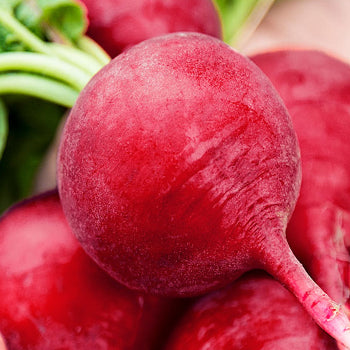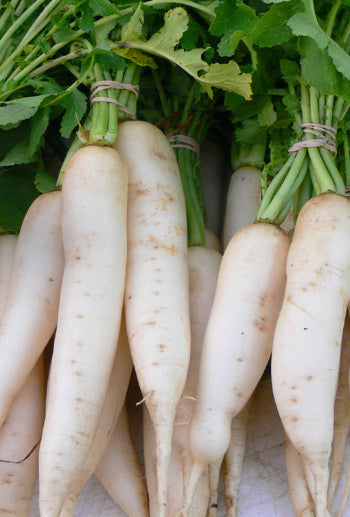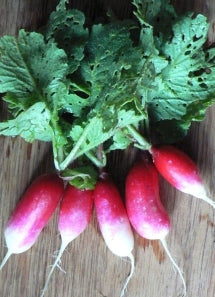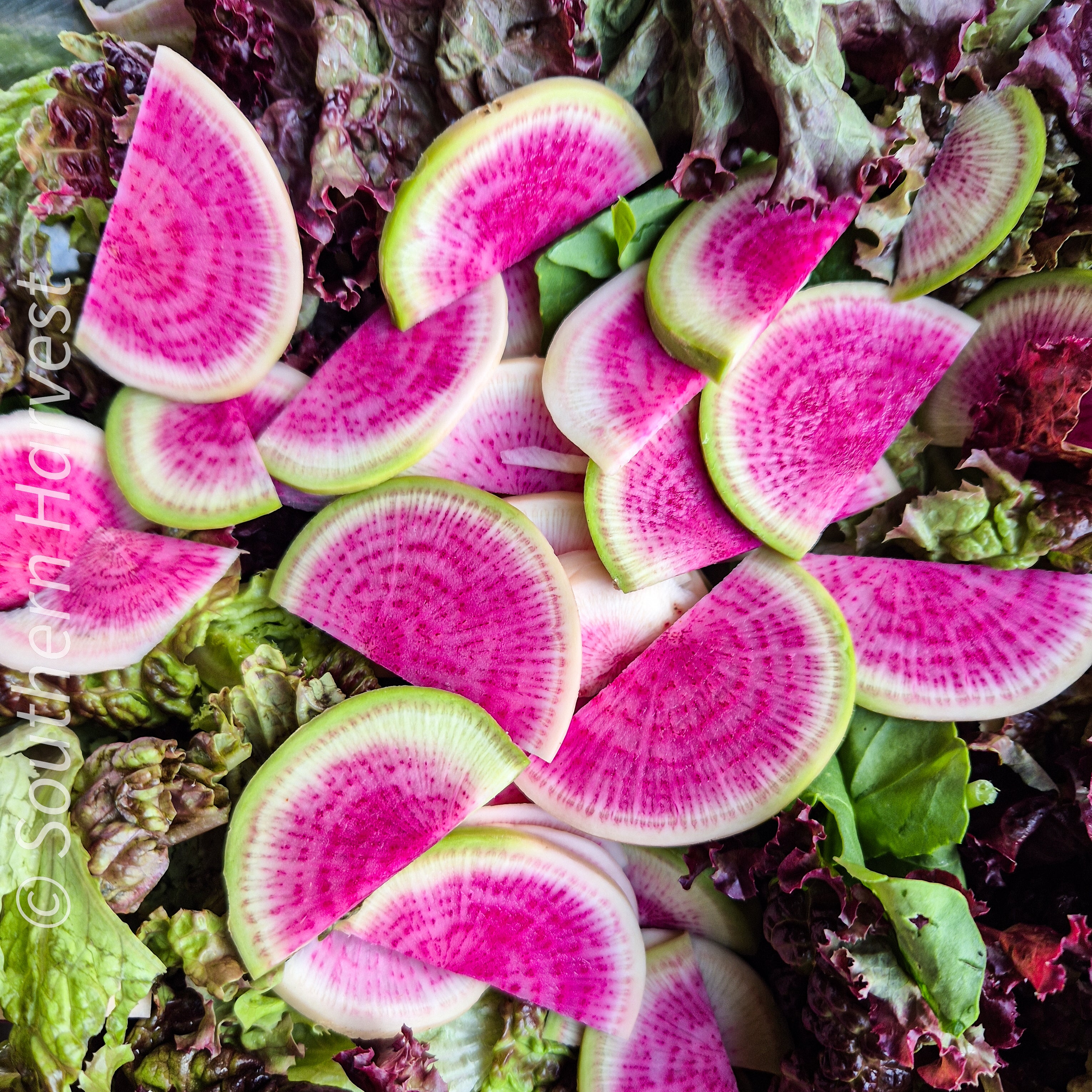How to Grow Radish

The essential guide to growing radish (Raphanus sativus) from seed; with notes on germination, cultivation, harvest and even kitchen uses.
At-a-glance: the radish tribe
- Summer/Salad radish – round or torpedo roots ready in under a month. Crisp, lightly peppery; eat raw, quick-pickle or grate over tacos.
- Winter radish – big Black Spanish, Watermelon and similar roots for cool-season sowings. Dense flesh and a fuller bite; great roasted, in stews or fermented.
- Oriental/Daikon – long white, green-shouldered or pink batons. Mild, juicy and versatile: shred for sushi, stir-fry, pickle or add to kimchi.
- Seed-pod “Rat-tail” radish – grown for crunchy green pods with a wasabi kick; toss into salads or tempura-fry.
Ave. Seeds per Gram: 80 – 110 seeds
Germinating Temperature: 10 – 25 °C; expect emergence in 3 – 6 days.
Feed Requirements:
- Moderate feeder.
- Work mature compost into the top 5 cm of soil.
- Excess nitrogen = lush tops, skinny roots; keep moisture even to avoid pithy or hot flesh.
Growing Notes:
Climate & Timing
- Cool regions can sow salad types every 2 – 3 weeks from early spring, to early autumn to ensure a constant supply of fresh radish.
- In temperate Australia skip the height of summer unless you can guarantee constant watering; winter radish go in Feb–Mar.
- Sub-tropics: main sowings Apr–Aug; cool zones can continue under cloches into Oct.
- Winter radish are best sown early to mid autumn as they prefer cooler weather.
Spacing & Depth
- Drill seed 1 cm deep.
- Salad types: 3 – 4 cm apart in rows 20 cm apart.
- Winter/daikon: thin to 10 – 15 cm in rows 30 cm apart.
- Radish make first-rate “catch crops”: sow between slower brassicas – you’ll eat the roots before neighbours need the space.
Variety Selection
- Choose globe reds like ‘Cherry Belle’ for speed,
- ‘French Breakfast’ for crunch,
- 'Daikon' for bulk fermenting, or
- colourful heirlooms (eg. 'Watermelon') for salad flair.
General Care
- Mulch lightly once seedlings appear.
- Water when the top 2 cm of soil dries – rapid, steady growth gives the sweetest, mildest roots.
Common Problems & Pests:
- Flea beetles pepper leaves – exclude with row covers.
- Aphids cluster on flower stalks – hose off or apply eco-oil.
- Hot, dry spells or overcrowding cause bolting and woody centres; keep sowings thin and moist.
- Clubroot in wet, acidic soils distorts roots – raise pH to 6.5–7 and improve drainage.
- Water regularly as sporadic heavy watering can cause roots to split.
Harvesting Notes:
When to Harvest
- Salad radish: 20 – 35 days after sowing, when roots are 2 – 3 cm across.
- Winter/daikon: 6 – 10 weeks, before skin cracks.
How to Harvest
- Grip foliage at soil line, twist and pull; or lift gently with a hand-fork in heavy soils.
- Remove tops to 1 cm to retain crunch.
Storage & Use
- Refrigerate salad radish in a perforated bag for up to two weeks.
- In colder areas winter and daikon roots can be kept in the ground and harvested as needed.
- Leaves are edible – sauté like spinach.
- Let a few plants bolt for zesty green seed pods or to save your own seed.
Enjoy the fastest “seed-to-salad” crop in the veggie patch – so quick it’ll make your head rad-ish!
Sowing Periods
| J | F | M | A | M | J | J | A | S | O | N | D | |
|---|---|---|---|---|---|---|---|---|---|---|---|---|
| Cool | ||||||||||||
| Temperate | ||||||||||||
| Sub-Tropical/Tropical |
Filters
8 products
Radish ‘German Giant’
Sale price$3.75
Radish 'Cherry Belle'
Sale price$3.75
RADISH ORIENTAL - Daikon 'Miyashige'
Sale price$3.75
RADISH – ‘French Breakfast’
Sale price$3.75
RADISH – ‘Nero Tondo’
Sale price$3.75
Radish ‘China Rose’
Sale price$3.75
RADISH ‘Easter Egg’
Sale price$3.75
RADISH ‘Watermelon’
Sale price$3.75








